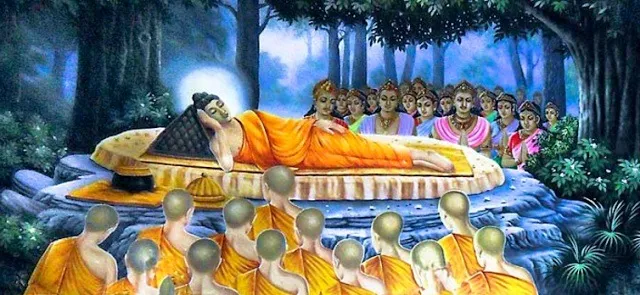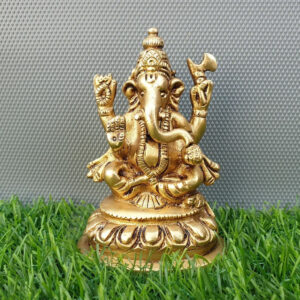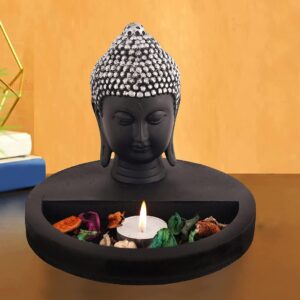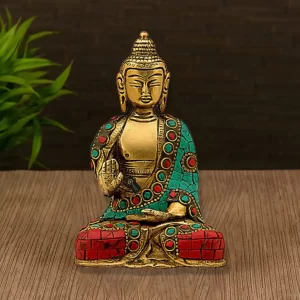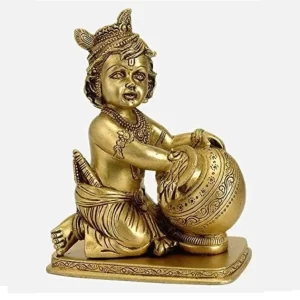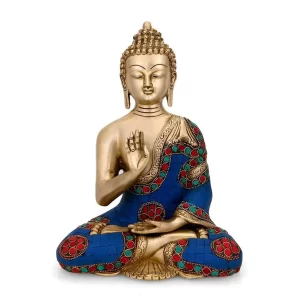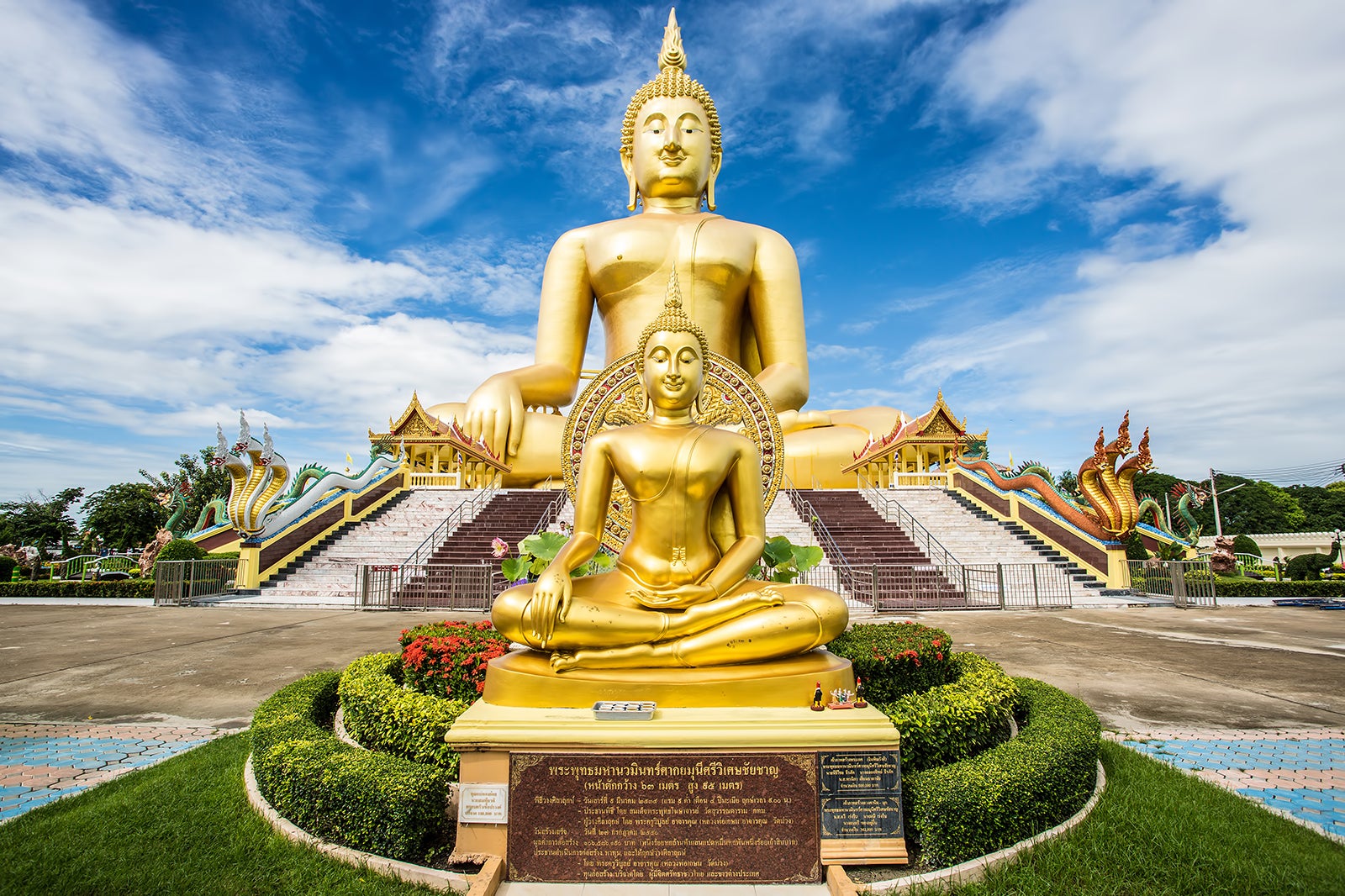
Top 4 Noble Truths of The Buddha and Buddhism
Buddhism is one of the world’s largest religions and originated in India, around the 5th century B.C.E.(2,500 years ago) with Siddhartha Gautama. Buddhism was spread in most of South Asian countries like Sri Lanka, Myanmar(Burma), China, Vietnam, Combodia, Laos, Thailand by King Ashoka, the last mighty ruller of Mauryan Empire. As the time passes, in the next millennia Noble Truths of Buddhism spread across Asia and the rest of the world.
Here in this blog you are going to learn about Four Noble Truths and Eightfold Path of Buddhism. Want to know more about Top 8 Buddha Statue Poses and Postures with their meaning?
If you are looking to Buy Buddha Statue Online at affordable rate, Taajoo is one of the best indian craft store. They provide free shipping in India, USA, Thailand, Vietnam or worldwide. Order Now !!
Buddhists believe that the human life is one of suffering, and that meditation, spiritual and physical labor, and good behavior are the ways to achieve enlightenment, or nirvana. Siddhartha Gautama was the first person to reach this state of enlightenment and was, and is still today, known as the Buddha.
Buddha Purnima (also known as Buddha Jayanti) celebrates the birth of Prince Siddharta Gautama. He was a Nepali prince (circa 563-483 B.C.) who later went on to become as the Buddha, the founder of Buddhism. The word ‘Purnima’ is Sanskrit for ‘full moon’, which explains why it is celebrated on a full moon day, and ‘Jayanti’ means ‘birthday’. The word Buddha is given to those who attain ‘bodhi’ or wisdom, hence the name was ascribed to Siddartha once he attained enlightenment. It is commonly celebrated during the month of ‘Vaisakhi’ in Hindu/Buddhist lunar calendars.
The Four Noble Truths are the core teachings of the Buddha, the founder of Buddhism. They are considered to be the foundation of Buddhist philosophy and practice. The Four Noble Truths are:
1- Dukkha: The Truth of Suffering
2- Samudaya: The Truth of the Origin of Suffering
3- Nirodha: The Truth of the Cessation of Suffering
4- Magga: The Truth of the Path to the Cessation of Suffering
Top 4 Noble Truths of The Buddhism
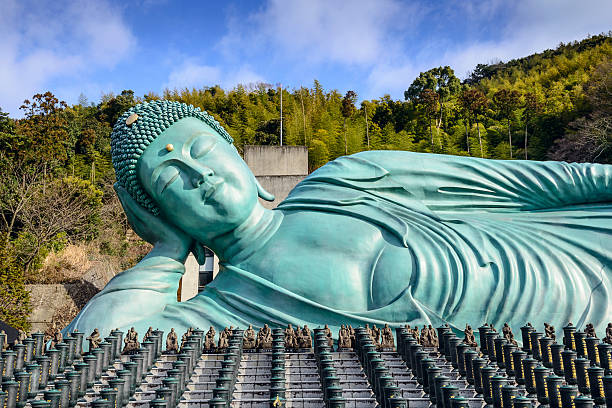
Dukkha: The Truth of Suffering
Dukkha, the first noble truth in Buddhism, is the truth of suffering. It teaches us that suffering is an inherent part of life and that all living beings are subject to suffering. This suffering can manifest in many different forms, including physical pain, emotional distress, and existential angst. According to the Buddha, there are three types of suffering:
1- Ordinary Suffering: This includes the physical and emotional pain that we experience in our everyday lives, such as illness, injury, grief, and anxiety.
2- Suffering Due to Change: This refers to the suffering that arises from the impermanence of all things. We often become attached to things that are temporary, such as relationships, possessions, and even our own bodies. When these things change or disappear, we experience suffering.
3- Suffering Due to Existence: This refers to the suffering that arises from our very existence as sentient beings. We are subject to the cycle of birth, aging, sickness, and death, and this can lead to a sense of existential unease or despair.
The Buddha taught that the cause of suffering is our attachment to things that are impermanent and our ignorance of the true nature of reality. He also taught that suffering can be overcome through the practice of the Noble Eightfold Path, which includes cultivating wisdom, ethical conduct, and mental development.
Samudaya: The Truth of the Origin of Suffering
Samudaya, the second noble truth in Buddhism, is the truth of the origin of suffering. It teaches us that the root cause of suffering is craving, attachment, and ignorance. In other words, our desires and attachments are what lead to suffering.
The Buddha taught that there are three main types of craving or attachment that give rise to suffering:
1- Craving for Sensual Pleasure: This refers to our attachment to sensory experiences such as pleasure, comfort, and satisfaction. We crave things like food, sex, and material possessions because we believe that they will bring us happiness.
2- Craving for Existence: This refers to our attachment to our sense of self or identity. We cling to the idea of a permanent, unchanging self and become attached to our beliefs, opinions, and identities.
3- Craving for Non-Existence: This refers to our desire to avoid pain, suffering, and unpleasant experiences. We may try to numb ourselves with drugs, alcohol, or other distractions in order to avoid discomfort.
The Buddha also taught that ignorance is a key factor in the origin of suffering. We are ignorant of the true nature of reality, including the impermanence of all things and the interconnectedness of all beings. This ignorance leads us to cling to false notions of self and to believe that our happiness is dependent on external factors.
In order to overcome the origin of suffering, we must cultivate awareness and wisdom. We must recognize our attachments and desires, and work to let go of them. We must also cultivate a deeper understanding of the nature of reality and the interconnectedness of all beings.
Nirodha: The Truth of the Cessation of Suffering
Nirodha, the third noble truth in Buddhism, is the truth of the cessation of suffering. It teaches us that suffering can be overcome and that there is a state of complete liberation from suffering known as Nirvana.
According to the Buddha, the cessation of suffering can be attained by eliminating the causes of suffering, which are craving, attachment, and ignorance. When we are able to let go of these mental states, we can attain a state of peace and contentment that is free from suffering.
The Buddha taught that there are four stages of enlightenment that lead to the cessation of suffering. These stages are:
1- Stream Entry: This is the first stage of enlightenment, where we gain a glimpse of the ultimate truth and begin to let go of our attachments and desires.
2- Once-Returner: At this stage, we have weakened our attachments and desires to a significant degree and have only one more rebirth before we attain Nirvana.
3- Non-Returner: At this stage, we have eliminated our attachments and desires to a great degree and will not be reborn in the realm of desire.
4- Arahant: This is the final stage of enlightenment, where we have completely eliminated our attachments and desires and have attained complete liberation from suffering.
The Buddha taught that the cessation of suffering is not a state that can be attained through external means, such as wealth or power. Instead, it is a state that must be attained through the development of inner qualities such as wisdom, compassion, and ethical conduct.
Magga: The Truth of the Path to the Cessation of Suffering
Magga, the fourth noble truths in Buddhism, teaches us that there is a path that leads to the cessation of suffering. This path is known as the Noble Eightfold Path and it consists of eight interconnected factors that work together to help us attain liberation from suffering. The Noble Eightfold Path is divided into three main categories: wisdom, ethical conduct, and mental development.
1- Wisdom (Panna)
The first two factors of the Noble Eightfold Path fall under the category of wisdom. They are:
• Right Understanding: This refers to the correct understanding of the nature of reality, including the Four Noble Truths. It involves understanding that everything is impermanent, that suffering is an inherent part of life, and that there is a way to overcome suffering and attain enlightenment. In conclusion, the Four Noble Truths are a profound and practical teaching that offers a path to freedom from suffering. By understanding and practicing these truths, we can develop wisdom, compassion, and inner peace. The Buddha’s teachings have been a source of inspiration and guidance for millions of people around the world for more than 2,500 years.
• Right Intention: This refers to cultivating the right attitude and motivation towards life. It involves having the intention to cultivate wholesome thoughts and actions, to be kind and compassionate towards oneself and others, and to let go of unwholesome thoughts and actions.
2- Ethical Conduct (Sila)
The next three factors of the Noble Eightfold Path fall under the category of ethical conduct. They are:
• Right Speech: This refers to speaking truthfully, kindly, and avoiding harmful speech. It involves refraining from lying, gossiping, harsh language, and divisive speech.
• Right Action: This refers to living in a way that is ethical and compassionate. It involves refraining from killing, stealing, and sexual misconduct.
• Right Livelihood: This refers to earning a living in a way that is honest and does not cause harm to others. It involves avoiding jobs that involve killing, stealing, or harming others.
3- Mental Development (Samadhi)
The last three factors of the Noble Eightfold Path fall under the category of mental development. They are:
• Right Effort: This refers to making an effort to cultivate wholesome thoughts and actions, and to overcome unwholesome thoughts and actions. It involves making an effort to let go of negative thoughts and emotions and to cultivate positive ones.
• Right Mindfulness: This refers to being aware of one’s thoughts, feelings, and bodily sensations in the present moment, without judgment or attachment. It involves cultivating a clear and focused awareness of the present moment.
• Right Concentration: This refers to the cultivation of a calm, focused, and one-pointed mind through meditation. It involves developing the ability to concentrate and focus the mind on a single object or point of focus.
What Happened After The Buddha Died (Parinirvana) ?
At the age of 80, after 45 years of teaching, the Buddha died, surrounded by a large group of his disciples. After the death of Buddha, his disciples institutionalized his teachings in schools which, fairly quickly (by 383 BCE, at the meeting known as the Second Council) led to disagreements about what his original vision was and the best way it should be lived. The first schism led to the establishment of the Sthaviravada and Mahasanghika schools from which developed many others. The three main schools in the present day are:
Theravada Buddhism (The School of the Elders)
Mahayana Buddhism (The Great Vehicle)
Vajrayana Buddhism (The Way of the Diamond)
All three schools differ from each other (though, technically, Vajrayana is a part of Mahayana) in their interpretation of Buddha’s vision and its application and all three claim to practice the original teachings. One of the main differences between the first two and the last centers on Truth 3 – cessation – in that both Theravada and Mahayana believe one must make the concerted effort to stop craving while Vajrayana believes that one must only recognize the first two truths and craving will end as one pursues lasting values and true reality, leaving illusion and the craving for impossible states of being behind as one embraces non-attachment to a world in which nothing remains the same and clinging to anything can only lead to suffering.
Conclusion
Buddhists believe that human life is a cycle of suffering and rebirth, but that if one achieves a state of enlightenment (nirvana), it is possible to escape this cycle forever. They do not believe in any kind of deity or god, although there are supernatural figures who can help or hinder people on the path towards enlightenment. The Noble Eightfold Path is a comprehensive and practical guide to living a life free from suffering. By cultivating wisdom, ethical conduct, and mental development through the eight interconnected factors, we can attain liberation from suffering and attain enlightenment.
As noted, not all Buddhist schools of thought understand and apply the Four Noble Truths and Eightfold Path in the same way.
Frequently Asked Questions (FAQ)
What are 4 Noble Truths of Buddhism ?
The Four Noble Truths are:
Life is suffering
The cause of suffering is craving
The end of suffering comes with an end to craving
There is a path which leads one away from craving and suffering
Why are the 4 Noble Truths important?
The Four Noble Truths are the foundational tenets of Buddhism, which spark awareness of suffering as the nature of existence, its cause, and how to live without it. The truths are understood as the realization which led to the enlightenment of the Buddha (l. c. 563 – c. 483 BCE) and were the basis of his teachings.
What are 8 Eightfold Path in Buddhism ?
The path alluded to in the fourth truth is The Eightfold Path which serves as both a guide on the road to non-attachment and the road itself. The precepts both inform a traveler on how to proceed and provide the way through spiritual discipline. The eight precepts are:
Right View
Right Intention
Right Speech
Right Action
Right Livelihood
Right Effort
Right Mindfulness
Right Concentration
Who spread Buddhism after Buddha died?
A famous king, named Ashoka, and his son helped to spread Buddhism throughout South India and into Sri Lanka (Ceylon) (3rd century B.C.E.). Many monastic schools developed among the Buddha’s followers.
How did buddhism spread after the death of buddha?
Most Buddhists believe that death marks the end of this life and the passage into the next. It is just one spoke among infinite spokes in samsara, the cycle of birth, death, and rebirth. According to the Buddha, beings go through countless births and deaths until they gain enlightenment.




